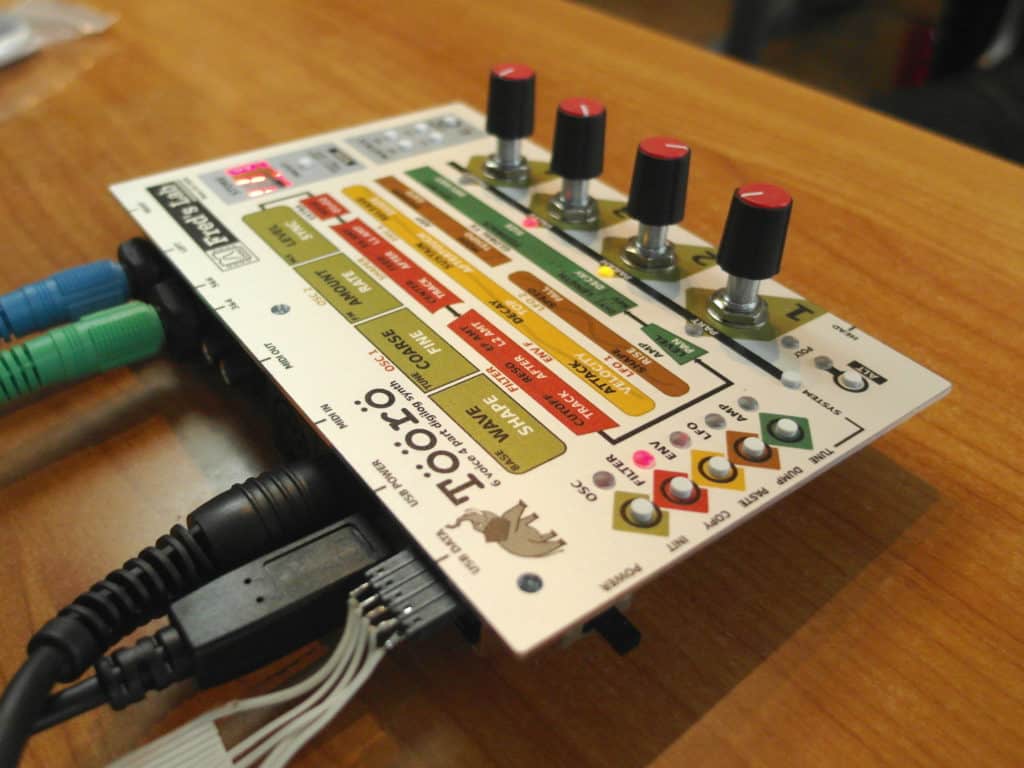Töörö an incredible synthesis with wavetables, FM, and analog filter
Töörö a 6-voice 4-part synthesizer with 12bit oscillators, analog filters and a digital multi-fx. Following two successful Kickstarter campaigns, independent synthesizer manufacturer Fred’s Lab is excited to announce a Kickstarter program for one of the bestvalue hybrid desktop synthesizer designs to date: the Töörö hybrid polyphonic supersynth.
Töörö (pronounced “tuh-ruh”) is a highly characterful 6-voice 4-part desktop polyphonic synthesizer, that packs incredible synthesis capabilities into an almost impossibly small space and price.

Töörö offers deep sound design potential, combining ‘gritty’ dual 12-bit wavetable oscillators inspired by the classic Microwave, shaped with through-zero FM synthesis, ring modulation and auto-sync. Modulation is provided by dual audio-rate LFOs, dual AHDSR envelope generators, and global stereo delay. Töörö’s FM and sync architecture includes ‘virtual operators’, allowing the creation of timbres that would normally require additional oscillators to achieve.
Töörö offers incredible sounds on tap. We crammed in two 12-bit wavetable oscillators full of fizz and grit, inspired by the classic Microwave, allowed each to be shaped further with FM synthesis, ring modulation and auto-sync, as well as a host of modulation and effects power. Our FM and sync architecture includes ‘virtual operators’, allowing timbres that would normally require additional oscillators.
Following specifications are preliminary and are subject to changes.
The Töörö is a polyphonic and multitimbral synthesizer module with 6 voices, 4 parts and a stereo signal path.

Sound Engine
Per voice
Oscillators
Two 12bit digital oscillators with:
– waveform morphing
– factory and user tables
– additional sine modulator (for linear through zero phase modulation)
– auto-sync feature – hardsync
Filter
A single FL A847 optocoupler based 12dB/Octave low-pass filter with auto-oscillation and saturation features.
Shaper
A selection of shapers and filters algorithms from Fred’s Lab.
Noise
A regular white noise source.
Ring modulator
An audio rate multiplication of osc1 output by osc2 output.
Envelopes
Two ADSR envelopes with hold stage and multiple triggering options.
LFOs
Two complex LFOs with various waveforms and their own AD envelope.
DCA
A digitally controlled attenuator with volume and panning control.
Per part
MIDI channel selection, overall part volume and panning.
A syncable arpeggiator with multiple modes and patterns is included.
Global
Multi-FX
A 12bit digital multi-FX module with:
– stereo ping-pong delay (with length, feedback and mix)
– chorus / flanger effect (with mode, speed and depth)

Instrument
Memory
The Töörö can store:
– 100 sound presets
– 10 multis
Connectivity
– 2 line-level unbalanced 6.35mm jacks (mix left & right)
– 2 instrument-level 3.5mm jacks for separate voice outputs (for voice 1-4 only)
– 1 DIN5 MIDI-IN
– 1 DIN5 MIDI-OUT (OUT + THRU configurable)
– 1 USB 1.1 B compatible port (for power and MIDI over USB)
– 1 power switch
UI
– 4 high-quality metal encoders
– 14 tactile switches
– dual digit 7-segment hexadecimal display
– 12 leds
Mechanics
– aluminum industrial enclosure
– quality rubber feet
– 170 x 120 x 45 mm
– 750 grams
Töörö can make fat, analogue-style tones with saw, square and sine waveforms, and uses a unique resonant filter inspired by the MS-10, but it can also make crisp digital soundscapes, pads and tones that are all its own.
Töörö is multitimbral. Sequence up to 4 different sounds at the same time, and create a whole track. Layer parts to create enormous, complex tones, or play up to 6-note chords, panning each note in the stereo field for lush, all-encompassing sound.
Töörö is easy to use. You can learn to quickly navigate and tweak sounds, make modulations and save and recall your sonic creations.
Töörö offers unique sounds to any electronic music setup. It combines what digital signal processing is incredible for, making complex, wild yet musical tones, and what analog is incredible for, making characterful, unpredictable and satisfying sounds that can’t ever be emulated in a computer.

Backed up by a three-year warranty, Töörö is built to last, a device you can rely on both in the studio, and on stage.
Töörö packs incredible synthesis capability, with wavetables, FM, and a wild new analog filter, into a tough, tweakable desktop case that can go anywhere.

Explore its characterful and deep sound design possibilities on the front panel, to create powerful live multitimbral arrangements using its 4-part 6-voice sound engine with built-in stereo delay and individual outputs.

Töörö Planned Features
- 6 voices of analog/digital hybrid synthesis.
- 4 part multitimbral, with stereo 1/4″ and 3.5mm individual outputs.
- Each voice features dual 12-bit wavetables, with morphing, auto-sync, and FM (with virtual modulation oscillators).
- Users can create custom wavetables using built-in waveforms.
- Unique highly-characterful 12dB/octave discrete analog “A847” filter, with wild resonance and multiple sweet spots.
- 2 AHDSR Envelopes.
- 2 LFOs with classic and random waveforms, and rise and fall controls.
- Advanced global stereo delay effect with modulation and feedback controls.
- 100 user-presets and 10 user-multi available for onboard sound storage and recall.
- Edit all sound parameters, parts and settings quickly and intuitively from the front panel matrix.
- Extensive MIDI implementation with DIN in and out, and smart thru function. All significant sound shaping parameters editable via MIDI CC – Responds to polyphonic after-touch messages.
- Compact dimensions of 70 x 120 x 45 mm, only 750g in weight.
- Rugged aluminum chassis, high-quality parts, non-slip design.
- USB powered – can be powered by computer, USB mains plug, or USB power bank. On/off power switch at rear.
- Features 3 year warranty.
- Made in Germany.

About Fred’s Lab
Based in Bonn, former capital of Germany, Fred’s Lab was founded by myself, Frédéric Meslin, a software and hardware designer and engineer. I have worked (under contract) on some very well-known and popular synthesizer products, some of which you may even own, or may be about to own, Töörö is Fred’s Lab third Kickstarter campaign, having successfully launched, funded and shipped two over projects and hundreds of units, with great feedback and happy backers

Pricing and Availability
Töörö is being launched exclusively via Kickstarter with a regular EU price of 399 Euros (inc 16% VAT), and limited ‘early bird’ pricing available of 349 Euros (inc VAT). The
is live now, and ends on the 13/11/2020 @ 22:00 UTC+1.















